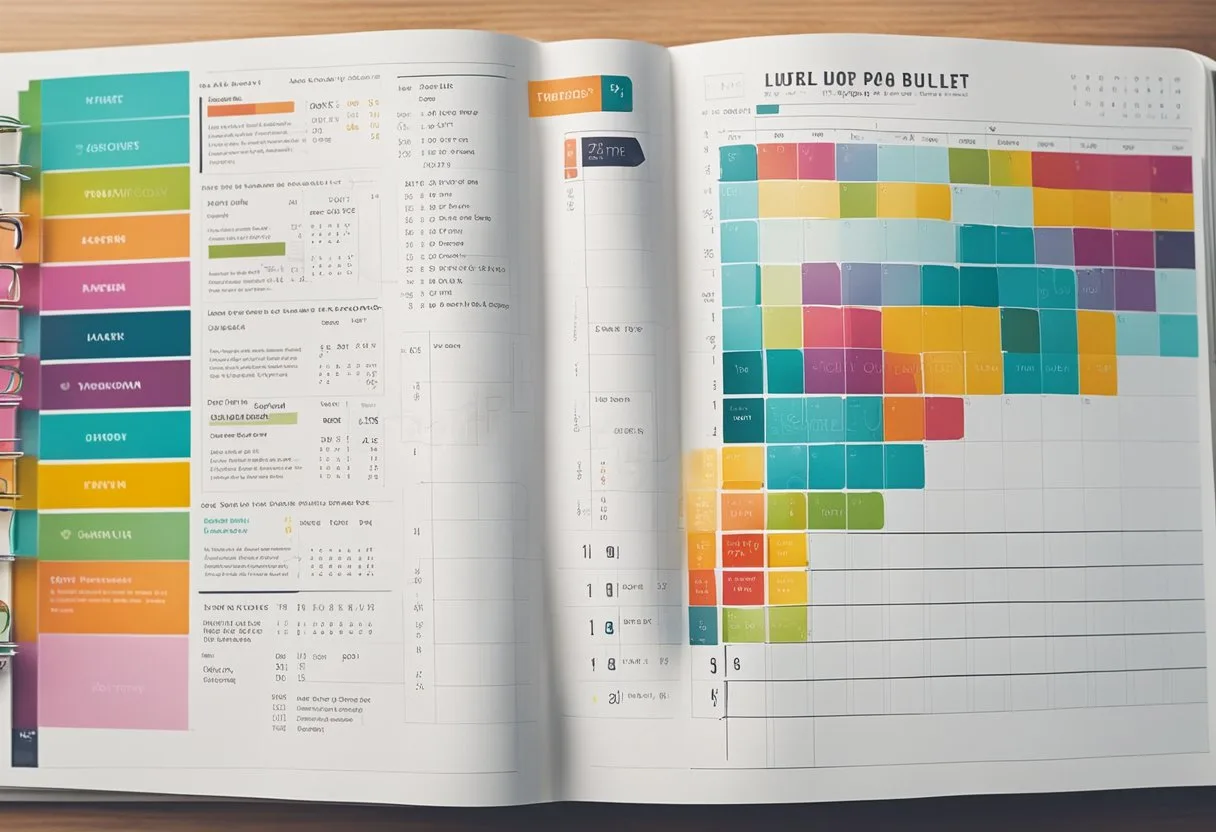Bullet journaling has become a popular method for organizing personal and professional tasks, but it can also be an effective tool for managing finances. A bullet journal budget planner allows individuals to track their income and expenses in a customizable and easy-to-use format. By utilizing a bullet journal for budgeting, individuals can gain a better understanding of their financial habits and make adjustments as needed to reach their financial goals. In this blog post, I will share with you tips and tricks for using bullet journal budget planner to track your finances.
One of the benefits of using a bullet journal for budgeting is the ability to create personalized layouts and trackers that fit individual needs. This can include monthly expense trackers, savings goals pages, and debt repayment plans. By having all financial information in one place, individuals can easily identify areas where they need to cut back or make changes to reach their financial goals.
Another advantage of using a bullet journal for budgeting is the flexibility it provides. Unlike traditional budgeting methods, which can be rigid and difficult to adjust, bullet journaling allows for changes and updates as needed. Individuals can add or remove pages as their financial situation changes, and can easily adjust their budget as needed to stay on track. Overall, a bullet journal budget planner can be a valuable tool for anyone looking to gain control over their finances and improve their financial well-being.
Getting Started with Your Bullet Journal Budget Planner
If you’re looking for a simple and effective way to keep track of your finances, a bullet journal budget planner might be just what you need. This system combines the flexibility of a bullet journal with the structure of a budget tracker, allowing you to create a personalized financial planning tool that works for you.
Understanding the Bullet Journal System
Before you start setting up your budget tracker, it’s important to understand the basics of the bullet journal system. At its core, a bullet journal is a customizable organizational system that uses bullet points, symbols, and collections to help you keep track of tasks, events, and notes.
To get started, all you need is a notebook and a pen. You can use any notebook you like, but many people prefer a dot grid or graph paper notebook to help with layout and design. From there, you can create pages for your monthly, weekly, and daily logs, as well as collections for things like books to read, movies to watch, and more.
Setting Up Your Budget Tracker
Once you have a basic understanding of the bullet journal system, you can start setting up your budget tracker. One popular way to do this is to create a monthly budget tracker, where you can track your income and expenses for the month.
To create a monthly budget tracker, start by creating a page with a table or grid that includes columns for income, expenses, and categories. You can then fill in each row with the appropriate amounts and categories, using symbols or colors to help differentiate between different types of expenses.
Choosing Your Budget Categories
When setting up your budget tracker, it’s important to choose the right categories to help you stay organized and on track. Some common budget categories include housing, transportation, food, entertainment, and savings.
However, you can customize your budget categories to fit your specific needs and lifestyle. For example, if you have a pet, you might want to include a category for pet expenses. Or, if you’re saving up for a specific goal, like a vacation or a down payment on a house, you can create a category for that as well.
A bullet journal budget planner can be a simple and effective way to take control of your finances. By understanding the basics of the bullet journal system, setting up your budget tracker, and choosing the right categories, you can create a personalized financial planning tool that works for you.
Tracking Your Finances
Tracking your finances is an essential aspect of budgeting. By keeping track of your expenses, income, savings, and debt, you can have a clear picture of your financial situation and make informed decisions. In this section, we will discuss the different ways you can track your finances using a bullet journal.
Creating a Monthly Budget Spread
A monthly budget spread is a visual representation of your income and expenses for the month. It helps you plan your spending and ensure that you do not overspend. To create a monthly budget spread, you can use a table or a chart. Start by listing your income sources and then your expenses. Be sure to categorize your expenses, such as housing, transportation, food, and entertainment. Calculate your total income and expenses and ensure that your expenses do not exceed your income.
Recording Expenses and Income
Recording your expenses and income is crucial to keep track of your spending habits. You can create an expense tracker and an income tracker in your bullet journal. An expense tracker helps you record your expenses and categorize them, making it easier to identify areas where you can cut back. An income tracker helps you keep track of your income sources and ensures that you receive all your payments.
Monitoring Savings and Debt
Monitoring your savings and debt is essential to achieving your financial goals. You can create a savings tracker and a debt tracker in your bullet journal. A savings tracker helps you keep track of your savings and set goals for yourself. It can be motivating to see your savings grow over time. A debt tracker helps you keep track of your debt and ensure that you are making progress towards paying it off. It can also help you identify areas where you can reduce your debt.
By tracking your finances using a bullet journal, you can have a clear picture of your financial situation and make informed decisions. Be sure to update your trackers regularly and review them periodically to identify areas where you can improve.
Enhancing Your Budget Planner

Utilizing Visuals and Layouts
One of the most significant advantages of bullet journaling is the ability to customize layouts and visuals to suit individual needs. A budget planner is no exception to this rule. Creative layouts and visuals can help users stay engaged with their budgeting process.
For instance, using tables, graphs, and charts can help users visualize their spending patterns, income, and savings. It is important to note that the visuals should be easy to understand and interpret.
Incorporating Financial Goals
Setting financial goals is a crucial step in budget planning. Bullet journaling provides an excellent platform to track progress and stay motivated. Users can set short-term and long-term financial goals and track their progress using bullet journal spreads. For instance, users can create a savings tracker spread to monitor their progress towards a financial goal. It is important to set realistic goals and celebrate milestones to stay motivated.
Leveraging Bullet Journal Supplies
Bullet journaling requires minimal supplies, and users can leverage these supplies to enhance their budget planner. For instance, using colorful pens, stickers, and washi tape can help users stay engaged with their budget planner. It is important to note that while using supplies can be fun, it should not take away from the primary purpose of budget planning.
Enhancing a budget planner using bullet journal ideas can help users stay engaged and motivated. Utilizing visuals and layouts, incorporating financial goals, and leveraging bullet journal supplies are some effective ways to enhance a budget planner.
Advanced Budget Planning Techniques
Adopting the Debt Snowball Method
For individuals with multiple debts, adopting the debt snowball method can be an effective way to pay off debts. This method involves listing debts from smallest to largest and focusing on paying off the smallest debt first while making minimum payments on all other debts.
Once the smallest debt is paid off, the focus shifts to the next smallest debt, and so on until all debts are paid off. The idea behind this method is to gain momentum and motivation by seeing progress in paying off debts.
Planning for Emergency Funds
Planning for emergency funds is an essential part of financial planning. An emergency fund is a reserve of money set aside for unexpected expenses such as medical bills, car repairs, or job loss. A good rule of thumb is to have three to six months’ worth of living expenses saved in an emergency fund. This fund can be built up by setting aside a portion of income each month until the desired amount is reached.
Analyzing Spending Habits
Analyzing spending habits is crucial for effective money management. By tracking spending habits, individuals can identify areas where they can cut back and save money. Bullet journal budget planners can be used to track spending habits by creating categories for different types of expenses such as groceries, entertainment, and transportation. This information can then be used to create a budget and make adjustments to spending habits as needed.
Adopting advanced budget planning techniques such as the debt snowball method, planning for emergency funds, and analyzing spending habits can help individuals achieve financial stability and reach their financial goals.
Frequently Asked Questions
What are the essential elements to include in a bullet journal budget planner?
To create an effective bullet journal budget planner, it is essential to include the following elements:
- A monthly budget tracker to keep track of income and expenses
- A savings tracker to monitor progress towards financial goals
- A debt repayment plan to keep track of outstanding debts and payments
- An expense log to track daily expenses and identify areas where spending can be reduced
- A financial goals page to keep track of long-term financial objectives
How can I create a monthly budget tracker in my bullet journal?
Creating a monthly budget tracker in a bullet journal is simple. Start by creating a table with columns for income, expenses, and savings. Fill in the income column with your expected income for the month and the expenses column with your anticipated expenses. Subtract the expenses from the income to determine your savings for the month. Update the tracker regularly to ensure you are staying on track with your budget.
What are some effective strategies for tracking expenses in a bullet journal?
Some effective strategies for tracking expenses in a bullet journal include:
- Using a color-coded system to categorize expenses
- Recording expenses as soon as they occur to ensure accuracy
- Reviewing expenses regularly to identify areas where spending can be reduced
- Using a separate page for each month’s expenses to make it easier to track spending over time
Where can I find a bullet journal budget planner template?
There are many bullet journal budget planner templates available online. Some popular websites for finding templates include Pinterest, Etsy, and Bullet Journal Printables.
Can you recommend a printable bullet journal budget tracker?
There are many printable bullet journal budget trackers available online. Some popular options include:
- The Budget Planner by Clementine Creative
- The Budget and Financial Planner by Life is Messy and Brilliant
- The Budgeting Bundle by Planning Mindfully
What are some creative ideas for enhancing a budget journal?
Some creative ideas for enhancing a budget journal include:
- Adding motivational quotes or images to keep you inspired
- Using stickers or washi tape to add color and personality
- Creating a vision board to keep your financial goals in mind
- Adding a gratitude log to help you focus on the positive aspects of your financial journey



